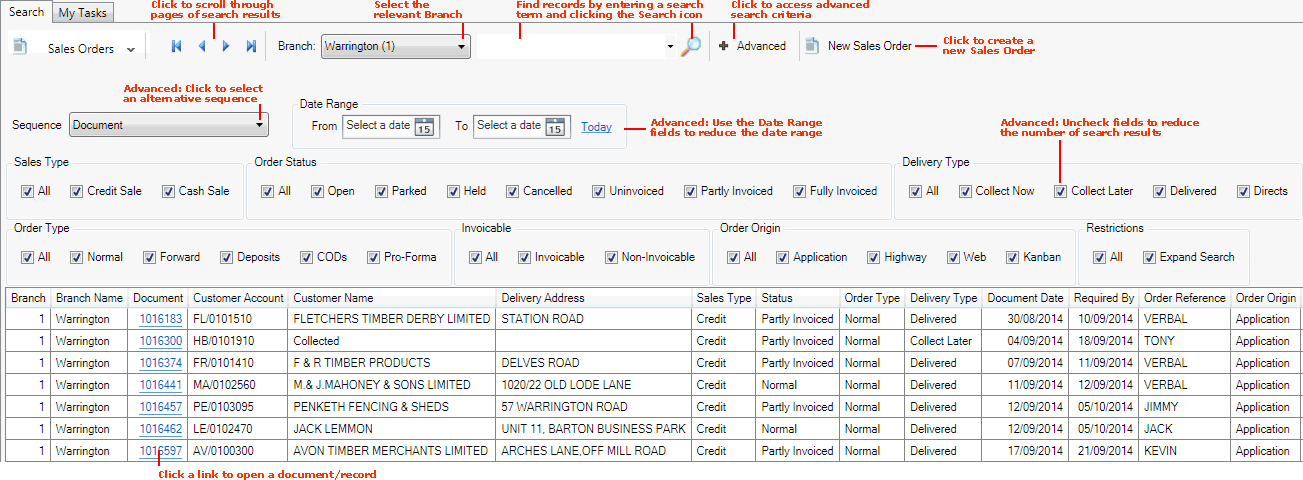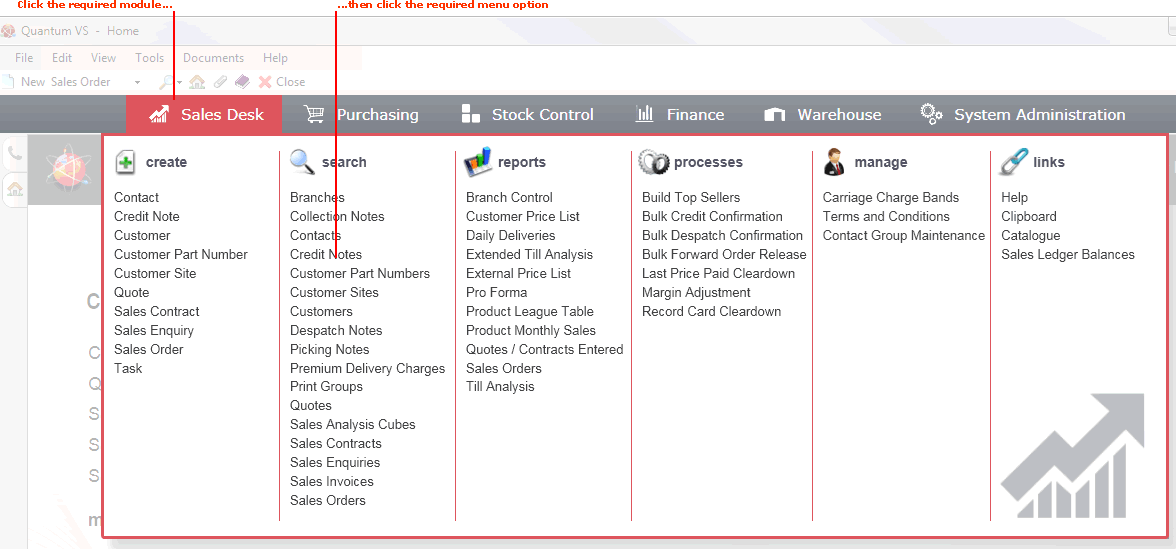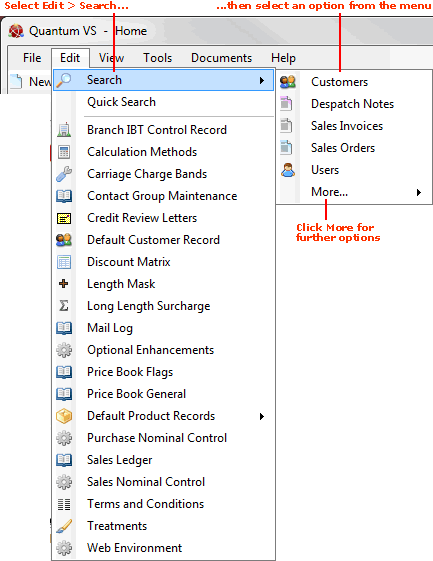Finding Sales Orders
You may use the Finder to:
-
show details of your Sales Orders;
-
locate specific Sales Orders; and
-
open a Sales Order record for viewing/editing.
Note: You may retrieve a Sales Order for a specific Customer by opening the Customer record - see Finding Customers - and opening the Sales Orders tab - see Sales Orders Tab: Viewing Customer Sales Orders. You may retrieve a Sales Order for a specific Product by opening the Product record - see Finding Products - and opening the Sales Orders tab - see Sales Orders Tab: Viewing Product Sales Orders.
Note: You may retrieve documents related to Sales Orders - such as Picking Notes, Despatch Notes and Sales Invoices - by retrieving a Sales Order and opening the Tracking tab. See Sales Orders: Tracking Progress After Completion.
Note: Rather than using your mouse, it is possible to use your keyboard to activate the required record type in the Finder, browse records in the Finder, then open the record in a new tab or add it to an open document. See Using Keyboard Shortcuts With The Finder.
Displaying Sales Orders In The Finder
To show Sales Orders in the Finder:
-
From the Home tab: under search, select Sales Orders.
-
Or: Use the search section in the Mega Menu to select Sales Orders.
-
Or: From the main menu: select Edit > Search, then select Sales Orders.
-
Or: In the Finder: click the 'down' arrow on the Search... button and select Sales Orders from the menu.
Your Sales Order records will be listed in the Finder. For example:

For further details and column definitions see Working With Sales Orders.
Note: Additional User Defined Fields will display in the Finder if the 'Show In Finder?' option was selected when Creating User Defined Fields. Fields will display data if it has been entered for a Sales Order.
Note: You may change the sequence of records displayed - see Changing The Search Sequence.
Browsing Sales Orders
If more than one page of records is displayed in the Finder you may click the blue arrow keys on the Finder Toolbar to scroll through pages of records and/or enter/select a page number. For example, entering 40 will show the 40th page of results. See Browsing Records in The Finder.
You may select the Branch which issued the Sales Order using the Branch menu on the Finder Toolbar.
Opening A Sales Order From The Finder
To open the required record from the Finder, either:
-
Click the Document hyperlink of the record you wish to open.
-
Or: Right-click on the line of the record, then select the View... option.
Note: You may also open Sales Orders via the hyperlinks on related sales documents, such as Picking Notes, Despatch Notes and Sales Invoices.
The record will open in a new tab. For further details see Working With Sales Orders.
Other Available Hyperlinks
The following hyperlinks are also available in this Finder. Click:
Changing The Sequence
You may wish to alter the sequence in which the records are displayed in the Finder. To do this:
1. Click Advanced on the Finder Toolbar.
2. The Search menu shows the current order in which records are displayed. To change the sequence, select an alternative option from the menu.
Sales Orders have the following Search options:
-
Document: Display Sales Orders (and search results) in Sales Order number order.
-
Account: Display Sales Orders (and search results) in Account order.
-
Required By: Display Sales Orders (and search results) in Required By date order.
-
Product: Display Sales Orders (and search results) which contain a named Product. For further details see Searching For A Specific Record below.
-
Product Code: See 'Product Code' Versus 'Product Record' Sequence Options.
-
Customer Name: Display Sales Orders (and search results) in Customer Name order.
-
Reference: Display Sales Orders (and search results) in Reference order.
-
Order Date: Display Sales Orders (and search results) in Order Date order.
-
Address: Display Sales Orders (and search results) in Delivery Address order.
-
Sales Rep: Display Sales Orders (and search results) in Sales Rep order.
-
Staff Code: Display Sales Orders (and search results) in Staff Code order.
You may also change the sort order by selecting either A to Z or Z to A.
You may filter records by date range by entering/selecting a date in the From and/or To Date Range fields.
3. Click the search (magnifying glass) icon  on the Finder toolbar. The records will be re-sequenced.
on the Finder toolbar. The records will be re-sequenced.
Searching For A Specific Record
To find a specific record without having to browse through pages of records:
1. Type an appropriate search term into the search field on the Finder Toolbar.
The search term you enter should relate to the Search option selected - see above. For example, if the Search option is Account then enter all or part of the Account number.
To find a Sales Order which contains a specific product: select Product in the Search menu before entering a product-related search term.
Note: You may click the down arrow within the search field to view and select a recent search.
2. Click the search (magnifying glass) icon  on the Finder toolbar.
on the Finder toolbar.
The records will be re-sequenced in the Finder, with the nearest matching record displayed at the top.
Filtering Sales Orders
You may use filters to control which records are displayed in the Finder. To filter Sales Orders:
1. Click Advanced on the Finder Toolbar.
2. If necessary, enter/select a date in the Date Range From and/or To fields (e.g. 01/01/20XX). Click Today to enter today's date.
On clicking the Search icon, only Sales Orders with a Document Date in the selected range will be displayed.
3. By default, Sales Orders of all (a) Sales Types, (b) Order Statuses, (c) Invoiced types, (d) Delivery Types, (e) Order Types, (f) Order Purposes, (g) 'Invoiceable' types and (h) Order Origin types are displayed in the results (i.e. all of the Sales Type, Order Status, Invoiced, Delivery Type, Order Type, Order Purpose, Invoiceable and Order Origin fields are checked). To reduce the number of results you may uncheck the following fields:
Sales Type:
-
All: Show Sales Orders of every Account Type
-
Credit Sales: Show Sales Orders which relate to Credit Sales
-
Cash Sales: Show Sales Orders which relate to Cash Sales
Order Status:
-
All: Show Sales Orders of every Order Status
-
Open: Show 'Open' Sales Orders
-
Parked: Show 'Parked' Sales Orders
-
Held: Show 'Held' Sales Orders
-
Cancelled: Show 'Cancelled' Sales Orders
-
Partly Invoiced: Show 'Partly Invoiced' Sales Orders
-
Fully Invoiced: Show 'Fully Invoiced' Sales Orders
Invoiced:
-
All: Show Sales Orders of every Invoiced status
-
Uninvoiced: Show 'non-Invoiced' Sales Orders
-
Invoiced: Show 'Invoiced' Sales Orders
Delivery Type:
-
All: Show Sales Orders of every Delivery Type
-
Collect Now: Show Sales Orders which relate to 'Collect Now' orders
-
Collect Later: Show Sales Orders which relate to 'Collect Later' orders
-
Delivered: Show Sales Orders which relate to 'Delivered' orders
-
Directs: Show Sales Orders which relate to 'Direct' orders
Order Type:
-
All: Show Sales Orders of every Order Type
-
Normal: Show Normal Sales Orders/lines
-
Forward: Show Forward Sales Orders/lines
-
Deposits: Show Deposit Sales Orders/lines
-
CODs: Show Cash On Delivery Sales Orders/lines
-
Pro-Forma: Show Pro-Forma Sales Orders/lines
Order Purpose:
-
All: Show Sales Orders of every Purpose type
-
Sale: Show 'Sale' type Sales Orders
-
Restock: Show 'Re-stock' type Sales Orders
Invoiceable:
-
All: Show Invoiceable and Non-Invoiceable Sales Orders
-
Invoiceable: Show Invoiceable Sales Orders (i.e. Sales Orders at the 'confirmed delivery' stage of the Sales Order Processing cycle)
-
Non-Invoiceable: Show Non-Invoiceable Sales Orders (i.e. Sales Orders which have been already invoiced or which are not at the 'confirmed delivery' stage of the Sales Order Processing cycle)
Order Origin:
-
All: Show Sales Orders of every Order Origin
-
Application: Show user-added Sales Orders (i.e. non-web-derived Sales Orders added by a user within the Quantum VS application)
-
Highway: Shows Sales Orders derived from Quantum VS Highway
-
Web: Show web-derived Sales Orders (i.e. orders added via a website)
-
Kanban: Show Sales Orders auto-generated from Kanban bar code scans (see Kanban Maintenance)
-
Standing Order: Show Sales Orders auto-generated from Standing Orders (see Working With Standing Orders)
You must ensure that at least one filter from each category listed above is selected, otherwise no results will be returned. For example, to show ONLY Parked Sales Orders:
-
Under Order Status, ensure only the Parked field is checked.
-
Ensure All or at least one field in each of the Sales Type, Invoiced, Delivery Type, Order Type, Order Purpose, Invoiceable and Order Origin sections are checked.
4. Click the search (magnifying glass) icon  on the Finder toolbar.
on the Finder toolbar.
The selected records will be displayed in the Finder.
Note: To list all records again: check the All field(s) and edit the Date Range fields as necessary then click the search (magnifying glass) icon  on the Finder toolbar.
on the Finder toolbar.
NEXT: Finding Special Price Records




